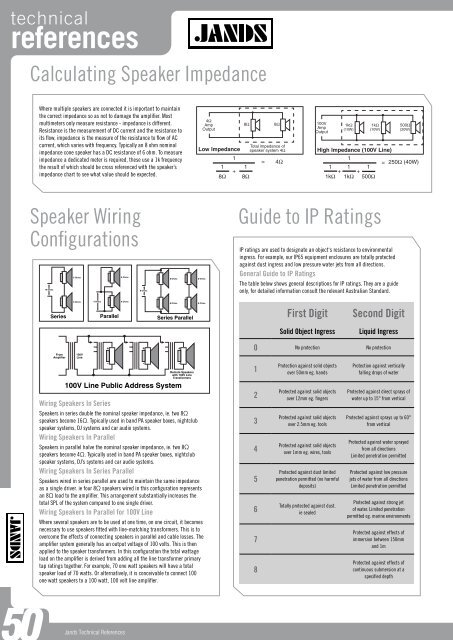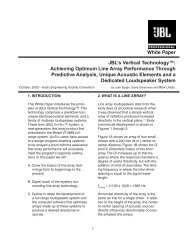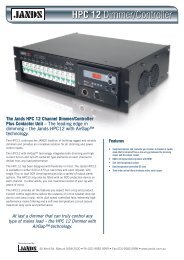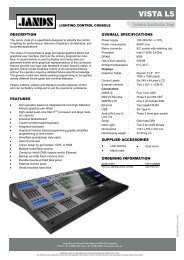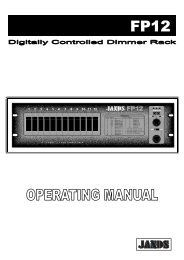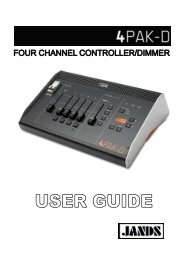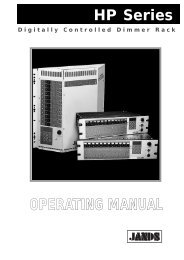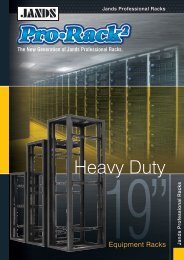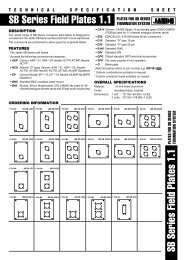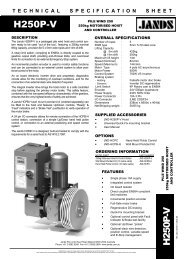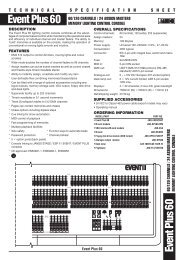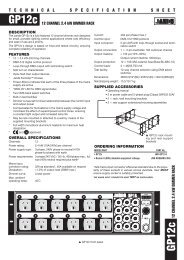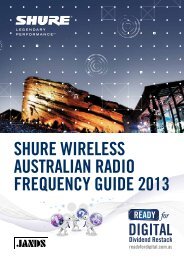A Guide to Quality Installed Sound Systems. - Jands
A Guide to Quality Installed Sound Systems. - Jands
A Guide to Quality Installed Sound Systems. - Jands
You also want an ePaper? Increase the reach of your titles
YUMPU automatically turns print PDFs into web optimized ePapers that Google loves.
technical<br />
references<br />
Calculating Speaker Impedance<br />
Where multiple speakers are connected it is important <strong>to</strong> maintain<br />
the correct impedance so as not <strong>to</strong> damage the amplifier. Most<br />
multimeters only measure resistance - impedance is different.<br />
Resistance is the measurement of DC current and the resistance <strong>to</strong><br />
its flow, impedance is the measure of the resistance <strong>to</strong> flow of AC<br />
current, which varies with frequency. Typically an 8 ohm nominal<br />
impedance cone speaker has a DC resistance of 6 ohm. To measure<br />
impedance a dedicated meter is required, these use a 1k frequency<br />
the result of which should be cross referenced with the speaker’s<br />
impedance chart <strong>to</strong> see what value should be expected.<br />
Speaker Wiring<br />
Configurations<br />
<strong>Guide</strong> <strong>to</strong> IP Ratings<br />
IP ratings are used <strong>to</strong> designate an object‘s resistance <strong>to</strong> environmental<br />
ingress. For example, our IP65 equipment enclosures are <strong>to</strong>tally protected<br />
against dust ingress and low pressure water jets from all directions.<br />
General <strong>Guide</strong> <strong>to</strong> IP Ratings<br />
The table below shows general descriptions for IP ratings. They are a guide<br />
only, for detailed information consult the relevant Australian Standard.<br />
First Digit<br />
Solid Object Ingress<br />
Second Digit<br />
Liquid Ingress<br />
0 No protection No protection<br />
1<br />
Protection against solid objects<br />
over 50mm eg. hands<br />
Protection against vertically<br />
falling drops of water<br />
Wiring Speakers In Series<br />
Speakers in series double the nominal speaker impedance, ie. two 8Ω<br />
speakers become 16Ω. Typically used in band PA speaker boxes, nightclub<br />
speaker systems, DJ systems and car audio systems.<br />
Wiring Speakers In Parallel<br />
Speakers in parallel halve the nominal speaker impedance, ie. two 8Ω<br />
speakers become 4Ω. Typically used in band PA speaker boxes, nightclub<br />
speaker systems, DJ’s systems and car audio systems.<br />
Wiring Speakers In Series Parallel<br />
Speakers wired in series parallel are used <strong>to</strong> maintain the same impedance<br />
as a single driver. ie four 8Ω speakers wired in this configuration represents<br />
an 8Ω load <strong>to</strong> the amplifier. This arrangement substantially increases the<br />
<strong>to</strong>tal SPL of the system compared <strong>to</strong> one single driver.<br />
Wiring Speakers In Parallel for 100V Line<br />
Where several speakers are <strong>to</strong> be used at one time, on one circuit, it becomes<br />
necessary <strong>to</strong> use speakers fitted with line-matching transformers. This is <strong>to</strong><br />
overcome the effects of connecting speakers in parallel and cable losses. The<br />
amplifier system generally has an output voltage of 100 volts. This is then<br />
applied <strong>to</strong> the speaker transformers. In this configuration the <strong>to</strong>tal wattage<br />
load on the amplifier is derived from adding all the line transformer primary<br />
tap ratings <strong>to</strong>gether. For example, 70 one watt speakers will have a <strong>to</strong>tal<br />
speaker load of 70 watts. Or alternatively, it is conceivable <strong>to</strong> connect 100<br />
one watt speakers <strong>to</strong> a 100 watt, 100 volt line amplifier.<br />
2<br />
Protected against solid objects<br />
over 12mm eg. fingers<br />
Protected against direct sprays of<br />
water up <strong>to</strong> 15° from vertical<br />
3<br />
4<br />
5<br />
6<br />
7<br />
8<br />
Protected against solid objects<br />
over 2.5mm eg. <strong>to</strong>ols<br />
Protected against solid objects<br />
over 1mm eg. wires, <strong>to</strong>ols<br />
Protected against dust limited<br />
penetration permitted (no harmful<br />
deposits)<br />
Totally protected against dust.<br />
ie sealed<br />
Protected against sprays up <strong>to</strong> 60°<br />
from vertical<br />
Protected against water sprayed<br />
from all directions<br />
Limited penetration permitted<br />
Protected against low pressure<br />
jets of water from all directions<br />
Limited penetration permitted<br />
Protected against strong jet<br />
of water. Limited penetration<br />
permitted eg. marine environments<br />
Protected against effects of<br />
immersion between 150mm<br />
and 1m<br />
Protected against effects of<br />
continuous submersion at a<br />
specified depth<br />
<strong>Jands</strong> Technical References


